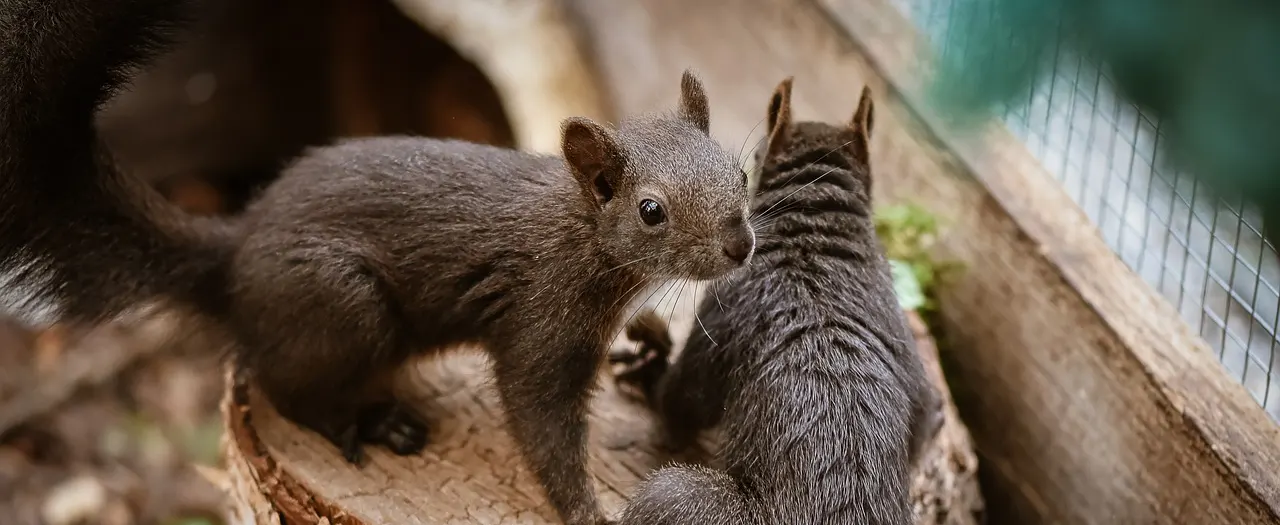You may mistake squirrel poop for rat or mouse droppings. Let’s determine what you are actually looking at and how to get it out of your home.

Identifying Squirrel Droppings
Squirrel droppings do look similar to rat droppings, but are generally a bit lighter in colour. In order to get rid of the animal we’ll need to take a closer look at “What does a Squirrel Poop look like?”
Size and Shape
Squirrel droppings are small, tubular pellets, roughly about 3/8 inch long and 1/8 inch in diameter, The center will be thicker than the rounded tips.
Colour and Consistency
Fresh droppings will be dark brown, but lighten in colour with age. Droppings may fade to light brown, gray, or even off-white.
Where to Find Squirrel Droppings
Unless you are tripping over squirrel droppings in your home and suspect squirrels have made themselves at home, you may need to go looking for evidence. Let’s be detectives!
Common Locations in and Around Homes
The most likely place for squirrels to seek refuge will be under your roof. Your attic can make a perfect place for a cozy nest for squirrels and raccoons alike. Read more on help with Squirrels or Raccoons in your attic » Similarly, your basement may be visited as well; cracks or larger openings in foundations often allow squirrels in.
Outdoor Areas
Outdoor sheds or storage bins may be a popular place for squirrels, especially, if you store any kind of bird or animal food there.
Distinguishing Squirrel Poop from Other Animal Droppings
Squirrels, like raccoons, prefer to use ‘latrines’. These are designated toilet areas. Of course, you wouldn’t mistake raccoon feces for squirrel poop but you may think along the lines of rats or mice. There are some distinguishing features to help you determine what you may be dealing with.
Rat Droppings vs. Squirrel Droppings
Squirrel poop - what does it look like? It’s small, brown, tube-like, and rounded at both ends. A tell-tale sign is a latrine with older and new droppings. The same size droppings will be present in different shades - from dark brown all the way to beige or almost off-white.
Rat droppings, on the other hand, are dark (almost black) and shiny when fresh and a more dull or dusty look when aged. They can be up to an inch in length and can vary in shape, depending on the type of rat producing them. There will be groups of pellets but not a latrine.
Other Similar Animal Feces
Although smaller, mouse poop shares characteristics with both rat and squirrel droppings. The main difference here is size.
Health Risks Associated with Squirrel Droppings
As with all animal feces, caution and adequate PPE is strongly advised. If you are not certain how or comfortable with safely removing squirrel droppings, it’s best to call in a professional wildlife removal company.
Diseases Transmitted Through Feces
Leptospirosis: A bacteria found in rodent feces and urine that can be transmitted to humans through contaminated food or water. Symptoms may appear flu-like and escalate to serious respiratory issues and even death.
Salmonellosis: Harmful bacteria that can be transferred to humans through inhalation, coming into contact with contaminated feces. Common symptoms include fever, abdominal cramps and diarrhea.
Other Health Concerns in regards to Squirrels
Ticks and fleas: Although not strictly found in squirrel droppings, squirrels often bring in ticks and fleas which easily transfer to and between human and pet hosts. Ticks are especially dangerous due to their association with Lyme disease. Symptoms include stiffness, nerve pain and inflammation of the spinal cord or brain.
Safety Precautions When Cleaning
Cleaning up after any wild animal comes with potential dangers. At bare minimum, you should be wearing gloves and a N95 mask. The clothes you wear during the task should be immediately run through the wash. Triple bag any droppings collected and discard.
Signs of a Squirrel Infestation
There can be a number of signs tipping you off to unwanted squirrel guests in your home. They aren’t known for their stealthiness :) Pitter patter on the roof or your attic floor, the unmistakable chitter chatter, and of course, the presence of a latrine.
Droppings as an Indicator
Now that you know what a squirrel latrine looks like, you’ll be in a much better position to identify the intruder in your home. If and when you do see a latrine like area with droppings as described, it is time to take immediate action.
Squirrel Damage
Squirrels can cause a huge amount of damage in their efforts to gain access to your home and to make themselves a cozy nook fit for nesting. From damage to your roof, your insulation to chewed wiring and potential fire hazards - squirrels are not the type of tenants you want.
Preventing Squirrels from Entering Your Property with Hawkeye
At Hawkeye, we not only deal with squirrel removal and repair the damage they left behind, but also find and implement ways to prevent them from doing so again in the future. Contact Hawkeye Bird & Animal Control today; one of our licensed, experienced wildlife removal technicians is standing by and ready to help.














